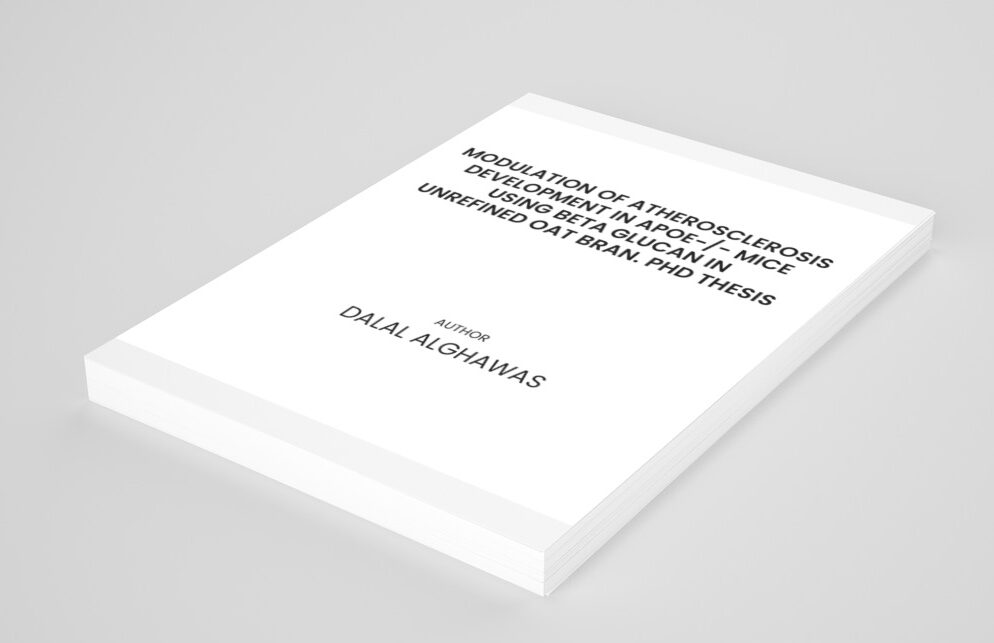
Publication: The University of Hong Kong
Abstract of thesis entitled: Modulation of atherosclerosis development in ApoE-/- mice using beta glucan in unrefined oat bran Submitted by: AlGhawas, Dalal Samir for the Degree of Doctor of Philosophy at the University of Hong Kong in March 2017 Oat bran contains β-glucan a water soluble non-starch linear polysaccharide, approved as a cholesterol lowering agent by food safety administrations is commonly used to reduce the risk of heart disease. The molecular weight (MW) of oat β-glucan can vary depending on the extraction and fractionation methods and it is unclear whether the MW or the fractionation process have significant impacts on atherosclerosis. The aim of this study was to investigate unrefined oat bran and its effects in attenuating the development of atherosclerosis in vivo, with special focus on cholesterol lipids, vascular endothelial markers, polyunsaturated fatty acids (PUFA) and its metabolites in tissues, intestine barrier function tests and gut microbiota composition. To test this, apolipoprotein E-/- female mice were fed a high fat diet supplemented with three oat β-glucan fractionations; unrefined oat bran, high molecular weight (HMW) oat β-glucan fractionate and low molecular weight (LMW) oat β-glucan fractionate for 16 weeks. Atherosclerosis risk markers, such as plaque size, vascular endothelial markers and cholesterol lipoproteins were assessed. The PUFA composition was analysed in the unrefined oat bran, because of its high PUFA content, using the LCMS/MS method in the heart and liver tissues. The impact of oat β-glucan on the intestine barrier were assessed by measuring tight junction protein gene expression and plasma endotoxin. The gut microbiota composition was analysed using the next generation sequencing (NGS) method. The oat β-glucan fractionates clearly demonstrated an ability to differentially modulate markers of atherosclerosis disease progression, intestine barrier and gut microbiota composition. The unrefined oat bran and HMW oat β-glucan diet groups were effective in reducing plaque size. The unrefined oat bran diet had enhanced cholesterol lowering effects and increased tight junction protein gene expression. The HMW β-glucan diet suggested an enhanced intestine barrier by reducing colon lipid absorption and lowering plasma endotoxin levels. The LMW β-glucan reduced tight junction protein gene expression, but was still able to reduce endotoxin levels. The PUFA metabolism of unrefined oat bran suggests alpha linolenic acid (ALA) caused increased levels of heart and hepatic ALA and its oxidised metabolites, namely phytoprostanes in vivo. The unrefined oat diet group had the lowest levels FMO gene expression suggesting reduced choline metabolism bacterial by-products followed by different gut microbiota diversity to HMW and LMW oat β-glucan diet groups. Other than β-glucan, additional components such as dietary fibre, phytochemicals and PUFAs in the unrefined oat bran diet may be contributing to enhance improvements in atherosclerosis risk markers and intestinal barrier. The LMW β-glucan diet had the poorest outcomes, likely due to its low viscosity in the gut and inability to block the reabsorption of cholesterol. In conclusion, the unrefined oat bran was the most effective in attenuating the development of atherosclerosis with marked outcomes for the intestine barrier and gut composition.
